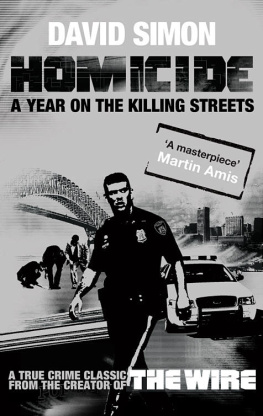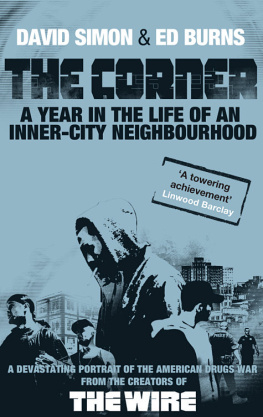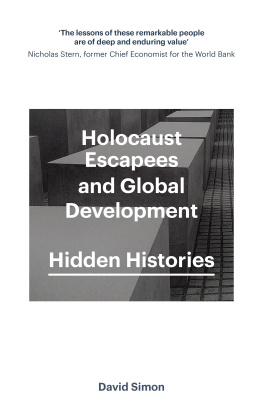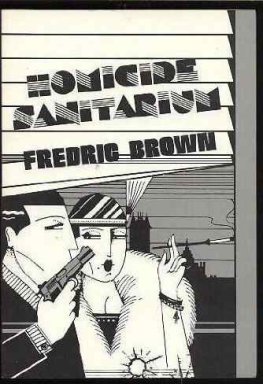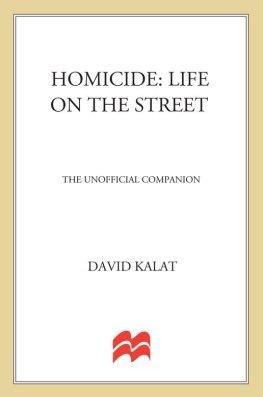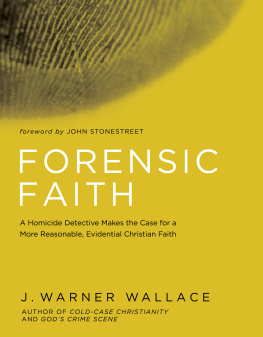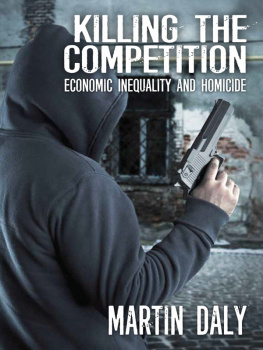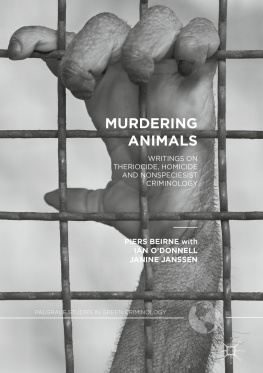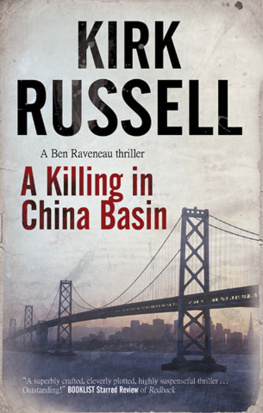David Simon - Homicide: A Year on the Killing Streets
Here you can read online David Simon - Homicide: A Year on the Killing Streets full text of the book (entire story) in english for free. Download pdf and epub, get meaning, cover and reviews about this ebook. year: 2006, genre: Detective and thriller. Description of the work, (preface) as well as reviews are available. Best literature library LitArk.com created for fans of good reading and offers a wide selection of genres:
Romance novel
Science fiction
Adventure
Detective
Science
History
Home and family
Prose
Art
Politics
Computer
Non-fiction
Religion
Business
Children
Humor
Choose a favorite category and find really read worthwhile books. Enjoy immersion in the world of imagination, feel the emotions of the characters or learn something new for yourself, make an fascinating discovery.
- Book:Homicide: A Year on the Killing Streets
- Author:
- Genre:
- Year:2006
- Rating:3 / 5
- Favourites:Add to favourites
- Your mark:
- 60
- 1
- 2
- 3
- 4
- 5
Homicide: A Year on the Killing Streets: summary, description and annotation
We offer to read an annotation, description, summary or preface (depends on what the author of the book "Homicide: A Year on the Killing Streets" wrote himself). If you haven't found the necessary information about the book — write in the comments, we will try to find it.
David Simon: author's other books
Who wrote Homicide: A Year on the Killing Streets? Find out the surname, the name of the author of the book and a list of all author's works by series.
Homicide: A Year on the Killing Streets — read online for free the complete book (whole text) full work
Below is the text of the book, divided by pages. System saving the place of the last page read, allows you to conveniently read the book "Homicide: A Year on the Killing Streets" online for free, without having to search again every time where you left off. Put a bookmark, and you can go to the page where you finished reading at any time.
Font size:
Interval:
Bookmark:
For Linda
If a man is found slain, lying in a field in the land the Lord your God is giving you to possess, and it is not known who killed him, your elders and judges shall go out and measure the distance from the body to the neighboring towns.
Then the elders of the town nearest the body shall take a heifer that has never been worked and has never worn a yoke and lead her down to a valley that has not been plowed or planted and where there is a flowing stream.
There in the valley they are to break the heifers neck.
The priests, the sons of Levi, shall step forward, for the Lord your God has chosen them to minister and to pronounce blessings in the name of the Lord and to decide all cases of dispute and assault.
Then all the elders of the town nearest the body shall wash their hands over the heifer whose neck was broken in the valley and they shall declare:
Our hands did not shed this blood, nor did our eyes see it done. Accept this atonement for your people Israel, whom you have redeemed, O Lord, and do not hold your people guilty of the blood of an innocent man.
Deuteronomy 21: 19
In contact wounds, the muzzle of the weapon is held against the surface of the body the immediate edges of the entrance are seared by hot gases and blackened by the soot. This is embedded in the seared skin and cannot be completely removed either by washing or vigorous scrubbing of the wound.
V INCENT J.M. D I M AIO M.D.,
Gunshot Wounds: Practical Aspects of
Firearms, Ballistics and Forensic Technique
ANTE MORTEM
by
Richard Price
Jimmy Breslin once wrote of Damon Runyon, He did what all good journalists dohe hung out. But in Homicide, his year-in-the-life chronicle of the Baltimore Police Departments Homicide Unit, David Simon didnt just hang out; he pitched a tent. As both a reporter and a dramatist Simon has always held the conviction that God is a first-rate novelist and to be there when Hes strutting his stuff is not only legitimate but honorable, part and parcel of fighting the good fight. Simon is a great collector and interpreter of facts, but hes also junkie and his addiction is to bearing witness.
I say this with authority (it takes one to know one), and the addiction plays itself out like this: whatever we see out on the streetwith the police, with the corner boys, with people who are just trying to survive with their families intact in a world sewn with every kind of land mineonly whets our desire to see more, to hang and to hang and to hang with whoever will have us in an endless quest for some kind of urban Ur-Truth. Our bedside prayer: Please, Lord, just one more day, one more night, let me see something, hear something that will be the key, the golden metaphor for all of it, which, as any degenerate gambler knows, is in the very next roll of the dice. Truth is right around the next corner, in the next bit of throwaway street commentary, the next radio call, the next hand-to-hand drug transaction, the next unfurling of crime scene tape, as the beast that is Baltimore, is New York, is urban America, like some insatiable Sphinx whose riddles arent even intelligible, continues to gobble up one benighted soul after another.
Or maybe its just our inability to meet deadlines .
I first met Simon on April 29, 1992, the night of the Rodney King riots. We had both just published Big Books: Simons was the book in your hands; mine was a novel, Clockers. We were brought together by our mutual editor, John Sterling. The moment was almost comical: David this is Richard; Richard, David. You guys should be friendsyou have so much in common. And so of course the first thing we did was make a beeline over the river to Jersey City, one of the hot spots that night, where we were met by Larry Mullane, a Hudson County Homicide detective and my ace Virgil for the previous three years of my writing life. Davids father had grown up in JC, the Mullanes and Simons had likely crossed paths over the generations, and so it went. The JC riots themselves proved elusive, perpetually around the corner but offstage, and my main recollection of that night is Simons compulsion to be there, which for me was like running into my long-lost Siamese twin.
Our second encounter was a few years later when, in the aftermath of the Susan Smith horror in South Carolina, I was on something of a Medea tour laying the groundwork for my novel Freedomland. There had been a vaguely similar tragedy in Baltimore: the white mother of two biracial girls had torched her rowhouse while her young daughters were asleep. Her alleged motive was to clear any obstacles from the path of true love with her new boyfriend, who she said was less than thrilled about her two kids (a suggestion he later denied).
Working the phones, David hooked me up with whatever principals were available to be interviewedthe arresting detectives, the mothers boyfriend, the thrice-bereaved grandmother, the Arab who owned the corner store across the street where the mother had fled, ostensibly to call 911. (Her first call, the store owner said, was to her mother, her c to report the fire.) Journalistically, the story was past its expiration date, but Simon, in his willingness to get me the story, reverted to work mode. It was the first time I ever had to keep pace with a street reporter both mentally and physically; in addition to securing all the interviews, this also involved unsuccessfully trying to jive and con our way past the uniform still guarding the crime scene; shrugging off the straight-arm and working an end run; circling around and scaling backyard fences until we found ourselves inside the blackened rowhouse; and climbing what was left of the stairs to enter the small bedroom where the two girls died of smoke inhalation. At last we were there, and it was like standing inside the gut of a translucent tiger, the two of us staring everywherewalls, ceiling, floorat the charred striations left by the flames. A devastating little chip of hell.
But lets go back to that first night in Jersey City. At one point during the evening there were rumors that the rioters were stringing piano wire across the streets to decapitate motorcycle cops, and Larry Mullane, an exmotorcycle cop himself, abruptly had to leave us. We found ourselves alone in an unmarked police car (an oxymoron if there ever was one), with me behind the wheel and Simon in the passenger seat. Mullanes advice to us was, Keep it movingand if anybody comes up on you, just try to look pissed off and floor it. Thats basically what we did, which brings me to a question that has always plagued me: Are writers like us, writers who are obsessed with chronicling in fact and fiction the minutiae of life in the urban trenches of America, writers who are dependent in large part on the noblesse of the cops to see what we have to see, are we (oh shit ) police buffs?
And the answer Ive come to believe is: No more than we are criminal buffs or civilian buffs. But for whoever allows us to walk a mile in their shoes, on either side of the law, we do feel an unavoidable empathyin essence we become embedded. But its not as sinister as it sounds as long as your Thank You mantra goes something like this: As a chronicler I will honor you with the faithful reporting of what I see and hear while a guest in the house of your life. As for how you come off, you dig your own grave or build your own monument by being who you are, so good luck and thanks for your time.
Simon writes with great thoroughness and clarity about the impossibility of the job of homicide investigator. For the murder police in the field, its not only the body lying before them that has to be dealt with but also what they carry on their backs, which is the entire hierarchy of bosses who answer to bossesthe weight of bureaucratic self-preservation. Despite the overpopularization of
Font size:
Interval:
Bookmark:
Similar books «Homicide: A Year on the Killing Streets»
Look at similar books to Homicide: A Year on the Killing Streets. We have selected literature similar in name and meaning in the hope of providing readers with more options to find new, interesting, not yet read works.
Discussion, reviews of the book Homicide: A Year on the Killing Streets and just readers' own opinions. Leave your comments, write what you think about the work, its meaning or the main characters. Specify what exactly you liked and what you didn't like, and why you think so.

